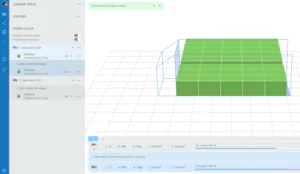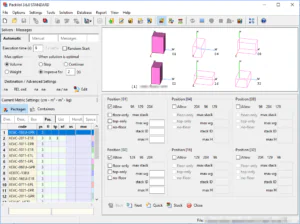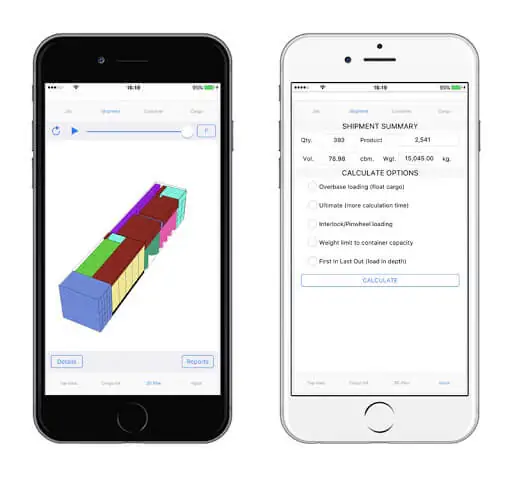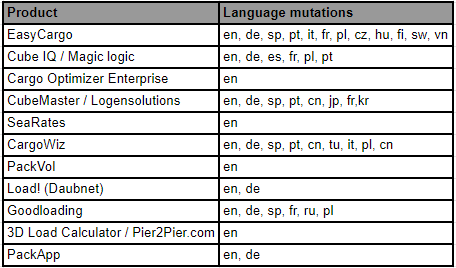Which is the best load planning application? (Part 2/4 – user experience)
In the first part, we discussed the functions that individual container and truck loading applications have. Today, we evaluate user-friendliness, quality of calculation, see if the programs have a mobile version, and if they are online. If you are more interested in pricing; you can skip to the third part. For the final results, read the last part of our mini-series.
The list of all tested applications with links to their websites is at the end of this article.
User-friendliness
It is undoubtedly useful to have a number of functions in the application, but it is equally important that the application environment is clean, and the application control is intuitive. The application’s goal is to save money and your time, so you don’t want to spend hours thinking about forcing the application to do what you want it to do.

Modern application layout
Source: Goodloading application
I rate the 3D Load Calculator and PackApp as the most user-friendly applications. Simplicity is redeemed by some missing features, but it is definitely an excellent choice for someone who doesn’t need them. The next in line is Goodloading, followed by EasyCargo. Also, both Goodloading and EasyCargo already offer more advanced features. Load!, CargoWiz, and Searates close the category of very intuitive applications for me. If you choose any of the tools from this paragraph, you will certainly get used to them quickly and easily.
Another category consists of applications that are not as intuitive as you would expect from a modern app but can still be used without much difficulty. These include Cube-IQ, Cargo Optimizer Enterprise, and CubeMaster. I would not choose these applications for their user-friendliness. However, I would not discourage anyone from buying them if they suit them perfectly, for example, with their functions.

Yes, some applications still look like this even in 2020
Source: PackVol application
The last category includes applications that are not intuitive at all, are very complicated, and take a very long time to run a simple calculation. From my selection, only PackVol falls into this category. Unfortunately, I have to say that of the 22 load planning applications I have tried, PackVol is by far the worst in terms of control. I could not orient myself at all. Even after half an hour of using the program, I could not start the calculation. Instead of the result, I kept getting error messages and they didn’t help me understand where the problem was. Therefore, I had to read the manual (which, by the way, has over a hundred pages!), and after another half an hour, I was finally able to run the first calculation. When I wanted to use an advanced feature, I had to look into the manual again.
On the other hand, as you already know from the previous section, PackVol has a large number of functions, and, as you will learn further, it also offers high-quality calculations. I recommend this application only to patient people, and at the same time, they need some of the features that the competition does not offer.
Is the application online?
Online applications have three main advantages – first, you don’t have to download or install anything. That can be advantageous, especially in corporations, where there are very strict policies for what may and may not be installed. The second advantage is the ability to use the application on any device with an Internet connection. Do you want to use the application on Thursday on your computer at work and Friday on your home office laptop? No problem! The third advantage is that the application is updated continuously.
From my selection, the following products are available online: 3D Load Calculator, Cube-IQ, CubeMaster, EasyCargo, GoodLoading, PackApp, and Searates. In contrast, Cargo Optimizer Enterprise, CargoWiz, Load!, and Packvol need to be downloaded and installed.
Quality of the outcome
Of course, the quality of the load plan is the most important attribute that we evaluate when choosing a load planning application. In my evaluation, I decided on the following method. I’ve selected four examples of different loads that I knew would fit in a given cargo space with almost no space left. These were hard to process for various reasons. In one example, some items had a lot of constraints (can’t be stacked, can’t be rotated, can’t be tilted). In the other example, there were dozens of different types of cost items, and so on.
Then, I evaluated the individual programs according to how many of these loads they managed to load into given cargo space. The programs which loaded all the examples received five points. Those applications that could only load three out of four loads received four points, etc. If the software wasn’t able to load a single example, it received one point.
Only Cube-IQ and PackVol scored five points, the best result. I gave four points to Cargo Optimizer Enterprise and EasyCargo. Two loads were loaded, and three points received Load! and Searates. I gave two points to 3D Load Calculator, CubeMaster, CargoWiz, and GoodLoading. Fortunately, not a single application was bad enough not to load any of the four examples.
Is the application optimized for mobile devices?
In today’s world of smartphones and tablets, it is an undeniable advantage to use the app on these devices. Although the planning itself will probably take place on a computer and you can print the result or view it on your mobile phone in pdf, the possibility to view, for example, a 3D model on a tablet is certainly intriguing.
Applications that are optimized for mobile devices include Cube-IQ, CubeMaster, and Searates. Cargo Optimizer Enterprise even has an application for Android and iPhone / iPad. Although the 3D Load Calculator (Pier2Pier.com) is not optimized for mobile devices, its interface is so simple that it can be used on phones/tablets except for viewing a 3D model.

Cargo Optimizer smartphone app for iPhone
Source: Cargo Optimizer application
Other solutions cannot run on mobile devices. That includes CargoWiz, Load!, PackApp, and PackVol. EasyCargo also belongs among them. However, although it is not possible to create a load plan on a phone or tablet, you can use the “desktop site” to open a so-called public link and view a step-by-step load plan or generate a preview of the load in pdf.
Localization
All applications from this list are in English. While this is not a problem for most, many people do not understand English or simply prefer the comfort of having the application in their preferred language. It is also important not to forget who will use the software. Maybe English is fine for the buyer or manager who decides to buy the software. However, colleagues in the warehouse who will use the program may have a different preference.
I divided the software into three groups and scored them. Those who supported only one language (English) received one point. Applications that supported 2-5 languages got two points. Applications that supported six or more languages received three points.
Cargo Optimizer Enterprise, SeaRates, PackVol, 3D Load Calculator, and LoadCargo were in the first group with one point. Load! and PackApp received two points. Cube-IQ, CubeMaster, CargoWiz, GoodLoading, and EasyCargo got three points. If you want to see if a specific application supports your language, use the table below.

Language mutation of various load planning software
In the next part, we will have a look at pricing.
Here are the Top 11 solutions with links to their websites: 3D Load Calculator, CargoWizz, Cargo Optimizer Enterprise, Cube-IQ, CubeMaster, EasyCargo, Goodloading, Load!, PackApp, PackVol, and SeaRates.




